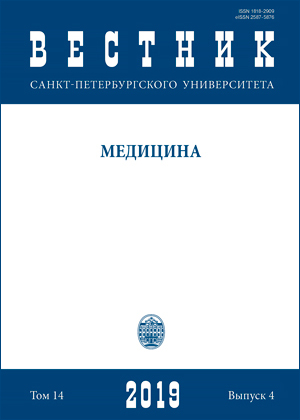Personalized prognosis of sarcoidosis based on the complex analysis of possible aetiological agents and mechanisms of immunopathogenesis
DOI:
https://doi.org/10.21638/spbu11.2019.417Аннотация
The current concept of immunopathogenesis of sarcoidosis is based on an exaggerated immune response to a specific unidentified antigen. In recent years, the high Th17-cell plasticity has been shown to play an important role in the pathogenesis of sarcoidosis, along with contribution of Th1. In this study an analysis of Tfh subpopulation composition in peripheral blood of patients with chronic sarcoidosis debut was performed. Electron microscopic analysis of the microbiological component of bronchoalveolar lavage fluid was conducted to identify infectious agents, in order to determine their aetiological significance in patients in the early stages of sarcoidosis. The data obtained indicate a shift in the balance of Tfh cells towards cells with proinflammatory phenotype, which may indicate their active participation in the immunopathogenesis of sarcoidosis. Commensal bacteria representatives of the normal microbiota were observed in bronchoalveolar lavage fluid. Morphological properties of macrophages witnessed for the active manifestation of their phagocytic function.
Ключевые слова:
sarcoidosis, cytokines, chemokines, immunopathogenesis, granuloma, electron microscopy
Скачивания
Библиографические ссылки
Ilkovich M.M., Baranova O.P. Sarcoidosis of Respiratory System. In: Interstitial and Orphan Lung Diseases. GEOTAR-MEDIA, M. 2016, 163-235. (in Russian)
Schupp J.C., Tchaptchet S. et al. Immune response to Propionibacterium acnes in patients with sarcoidosis – in vivo and in vitro. BMC Pulm Med. 2015; 15: 75.
Zimmermann A., Knecht H., et al. Atopobium and Fusobacterium as novel candidates for sarcoidosis-associated microbiota. European Respiratory Journal 2017 50: 1600746.
Suchankova M., Paulovicova E. et al. Increased Antifungal Antibodies in Bronchoalveolar Lavage Fluid and Serum in Pulmonary Sarcoidosis. Scandinavian Journal of Immunology 2015 81(4); 259–264.
Scher J.U., Joshua V. et al. The lung microbiota in early rheumatoid arthritis and autoimmunity. Microbiome 2016; 4:60.
Загрузки
Опубликован
Как цитировать
Выпуск
Раздел
Лицензия
Статьи журнала «Вестник Санкт-Петербургского университета. Медицина» находятся в открытом доступе и распространяются в соответствии с условиями Лицензионного Договора с Санкт-Петербургским государственным университетом, который бесплатно предоставляет авторам неограниченное распространение и самостоятельное архивирование.




